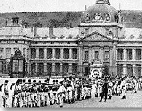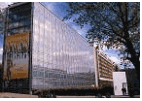INSTITUTIONS
Below are some other buildings around the city that deserve attention. Also, don’t forget to take a look at museums, monuments, districts and to visit.
UNESCO HEADQUARTERS

Source:
www.parisbalades.com
(métro Ségur, Cambronne)
(tel. 01 45 68 03 71, open 9.00-12.30 and 14.30-18.00 except Saturday and Sunday)(Architects Breuer, Nervi, Zehfuss, 1958).
UNESCO.
UNESCO, the United Nations Education, Science and Cultural Organisation, was created in 1945 to promote peace between nations through cultural exchange. The east side leads on to a Japanese garden where, in 1993, designer Charlotte Perriand added a tea room, built with bamboo and sailcloth. On the west side is an immense piazza decorated with modern art sculptures.
ASSEMBLEE NATIONALE

Source:
126 rue de l'Université
(pantings by Jean-Charles Blais)
(tel. 01 48 87 24 14 ou 01 40 63 77 77, open to visitors on Saturdays at 10.00, 14.00, 15.00 unless the Assembly is in session. Admission at 33 quai d’Orsay with identification. Assemblée Nationale. Situated facing Place de la Concorde, the Assemblée Nationale (also known as the Palais Bourbon) was built 1726 for the daughter of Louis XIV and Mme de Montespan, widow of the duc de Bourbon. All that remains of the original building is the façade on Rue de l’Université. This is where the members of the French parliament meet and it is the residence of the President of the National Assembly. Members of parliament, elected by universal suffrage for a period of 6 years, here carry out their role of proposing, debating, amending and voting on bills of legislation. For a law to be permanently adopted, it must also be passed by the Senate, the second house of parliament.
BOURSE DE PARIS - (PARIS STOCK EXCHANGE) PALAIS BRONGNIART

Source:
4 place de la Bourse (2è)
Tel: 01 42 33 99 83
Open: 13.30-15.00 Monday - Friday
Created in the 19th century by Napoléon, the stock exchange was designed by architect Alexandre Théodore Brogniart. Its purpose was to strengthen and encourage the prosperty of French industry and commerce. The surrounding area has become the financial quarter of the city.
HOTEL DE VILLE PARIS

Source:
www.parisbalades.com
LE PALAIS DE JUSTICE

Source:
www.parisbalades.com
M° Cité
Tel: 01 44 32 50 00
Open:
9.00-17.00 Monday - Friday
The main entrance to the Palais de Justice overlooks the Cour de Mai. Passing the steps into the Palais, one enters a merchant gallery which once was one of the liveliest spots in Paris. Coming back through the merchant gallery one can visit the Salle des Pas Perdus (Hall of Lost Footsteps). The Revolutionary Tribunal sat in this room.
HOTEL MATIGNON

Source:
www.parisbalades.com
métro Solférino, Rue du Bac, Varenne) (open only during the days of the Journées du Patrimoine Festival, mid-September) Begun in 1721, the building was sold shortly after completion to Jacques Goyon de Matignon, Count of Thorigny. In 1935, it was bought back by the state and the presidency of the council was established there. It became the residence of the prime minister in 1958.
PALAIS DE L’ELYSEE

Source:
www.parisbalades.com
(métro Champs-Elysées-Clémenceau, Miromesnil)
tél. 01 42 92 81 00 Erected in 1718 by Mollet for the Count of Evreux, The Palais de l’Elysée became the official residence of the President of the Republic in 1873. The palace can only be visited during the days of the heritage festival September: for this reason it is often necessary to wait as long as three hours to get to see the seat of French power.
L'ECOLE MILITAIRE

© Pariserve.com
M°Ecole militaire The Royal Military School was founded by Louis XV in 1751 with the help of Mme de Pompadour and the financier, Duverney. Its objective was to train impoverished gentlemen into military careers. Napoleon Bonaparte was a member of the school in 1784. The building was completed in 1752 and was designed by Gabriel.
LE COLLEGE DE FRANCE

Source:
www.parisbalades.com
(métroMaubert-Mutualité, Cluny-la-Sorbonne)
tel. 01 44 27 10 27, course programmes available at entrance) Founded in 1530 by François I, having been instigated by humanist Guillaume Budé, this “School for Royal Readers” favoured modern teachings that were refused by the university. Never ceasing to enrich its rostrum (which has featured such revered scientists as M. Berthelot, F. Joliot-Curie and anthropologist C. Lévi Strauss), the college has remained an unusual institution: it awards no diplomas, its lecturers do not necessarily come from universities, and the lectures are open to the general public.
LA SORBONNE

© Pariserve.com
M° Cluny la Sorbonne
Tel: 01 40 46 22 11
Open: 9.00-18.00 Monday - Saturday Robert de Sorbon, who became confessor to Saint Louis, founded a college in 1253 to allow those who were not rich to study theology. The Pope gave his approval and this establishment would later become the University of Paris. Cardinal Richelieu was elected Head Teacher of the Sorbonne in August 1622. As the number of students attending the college grew, it became equipped with lecture theatres, examination halls, laboratories, a library comprising over 2 million works, as well as an observatory. The international reputation of the Sorbonne, which has always been one of the most important universities in Europe, has entered into a long university tradition.
INSTITUT DU MONDE ARABE

Source:
M° Jussieu
Tel: 01 40 51 38 38
Open:
10.00-18.00 Tuesday – Sunday (payment on admission)
The Institute of the Arab World came about as a result of a convention between France and several of Arab countries to promote intercultural exchange. In designing this building, architect Jean Nouvel created a modern work of art, which seems to emit a sense of purity and harmony. The metal panels that control the lighting were inspired by the traditions of the Moucherabiehs. The IMA has a library, a museum on Muslim culture and numerous expositions are organised there. On the top story is a restaurant with a terrace that offers a splendid view of Notre Dame and Paris. Of course, Paris is replete with institutions of note you may wish to learn about, you may also be interested in other forms of cultural art, such as media.
- Paris-city Partners :
- Music News
- Rock, Jazz & Blues CDs
- Learn French in Paris
- Learn French in France
- Paris Junior Programs
- Learn English in England
- Business English Courses
- Need a translation?
- For teachers of French
- French Exercise & Tests
- Directories
- English courses for Teens in UK
- Camps for Teens in England
- Language Courses Abroad
- English courses in England
- Learn a Language Abroad


